Welcome to the buzzing world of North Carolina’s bees! These incredible insects play a vital role in our ecosystem, pollinating plants and supporting our environment.
But let’s face it: nobody wants to feel the wrath of their stings. That’s why we’re taking a deep dive into the ten types of bees found in North Carolina, ranked by the pain level of their stings.
Using the renowned Schmidt Sting Pain Index as our guide, we’ll help you identify each bee and learn about its habitats and distribution.
So let’s begin our journey through the fascinating and sometimes painful world of bees!
1: Western Honey Bee (Apis mellifera)

When it comes to stinging, western honey bees mean serious business.
©SanderMeertinsPhotography/Shutterstock.com
Meet the western honey bee, the all-star of the bee world and a familiar face in North Carolina! It’s also called the European honey bee. Famous for their honey-making abilities, these busy bees also pack a powerful punch with their stings. Let’s get acquainted with these buzzing champions.
Physical Characteristics
Western honey bees flaunt a distinctive striped pattern with alternating black and golden-yellow bands. Measuring around 0.5 inches in length, they’re slightly larger than some of their bee counterparts. Nevertheless, their iconic hexagonal honeycombs showcase their architectural genius.
Sting Pain Level: Most Painful
When it comes to stinging, western honey bees mean serious business. Scoring a 2.0 on the Schmidt Sting Pain Index, their sting ranks as the most painful on our list, delivering a burning sensation that can persist for hours. However, exercise extra caution around these stingers, as they can trigger allergic reactions in some individuals.
Habitat and Distribution
Western honey bees can be found buzzing around a wide range of habitats, from forests and meadows to suburban gardens. They’re highly adaptable and have made themselves at home all across North Carolina. Keep an eye out for their hive dwellings in tree cavities, rock crevices, or even man-made structures.
2: Eastern Carpenter Bee (Xylocopa virginica)
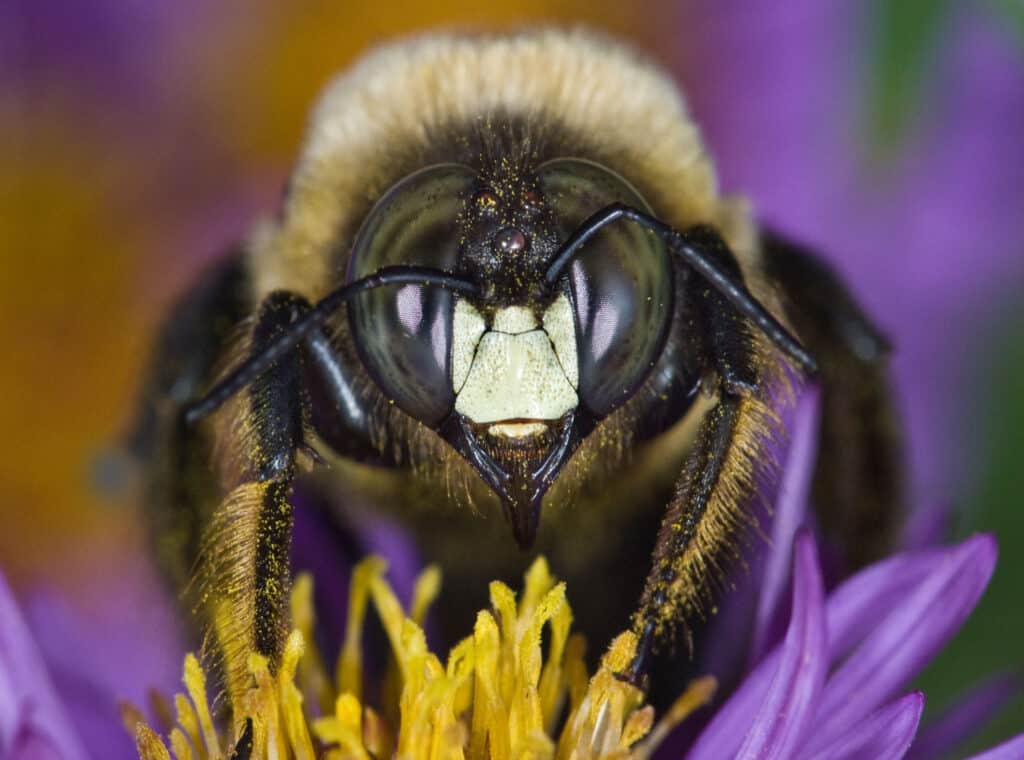
Carpenter bees have large eyes and a glossy, hairless abdomen.
©Gerry Bishop/Shutterstock.com
This is a fascinating and industrious member of the bee family. So often mistaken for bumblebees, these large, powerful bees are true artists when it comes to nest building. So let’s delve into the world of these amazing insects.
Physical Characteristics
Eastern carpenter bees boast a robust build, with a length of 0.5 to 1 inch. They’re primarily black with a metallic sheen, while their abdomen has a touch of yellow fuzz. What sets them apart is their incredible ability to carve intricate nests within wood, showcasing their woodworking skills.
Sting Pain Level: Most Painful
Eastern carpenter bees pack quite a punch with their stings. Scoring a 2.0 on the Schmidt Sting Pain Index, their stings are as painful as those of western honey bees. Though females can sting, they’re not overly aggressive, so caution is advised, but there’s no need for alarm.
Habitat and Distribution
You’ll encounter eastern carpenter bees throughout North Carolina, as they thrive in a variety of environments. They’re drawn to wooded areas and gardens, as well as human-made structures. Keep an eye out for their distinctive, perfectly round entrance holes in wooden surfaces, a telltale sign of their presence.
3: Bumblebees (Bombus spp.)
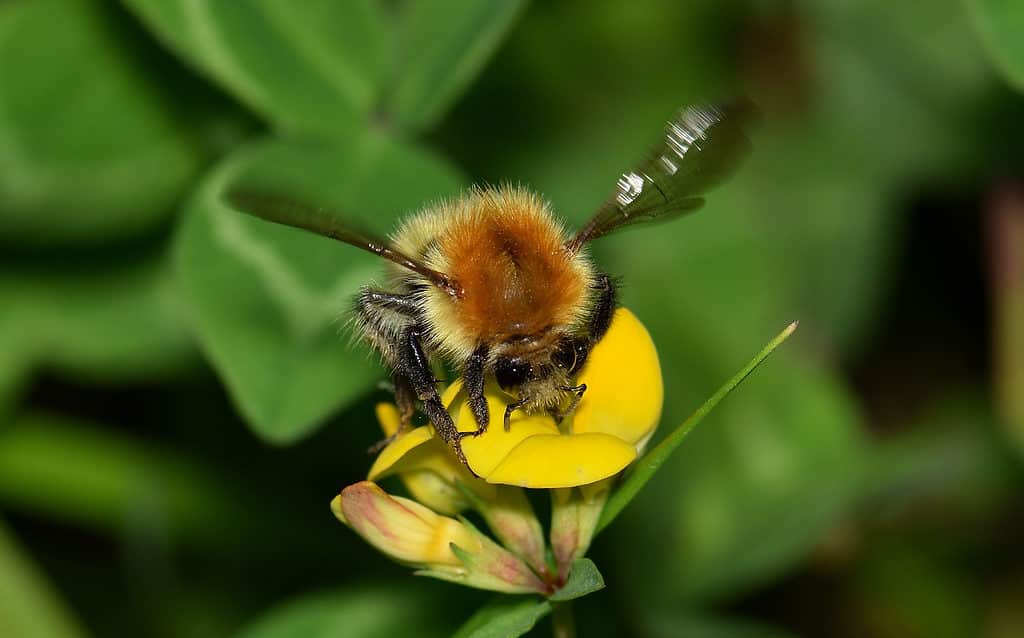
Keep an eye out for their nests, often found in the ground or in small cavities.
©iStock.com/Wirestock
Meet the fuzzy and friendly bumblebees, the charming, plump pollinators that are a delight to observe. Known for their endearing appearance and social nature, these bees are essential to the environment. Let’s get up close and personal with these buzzing bundles of joy.
Physical Characteristics
Bumblebees are easily recognized by their round, furry bodies adorned in black and yellow. They vary in size, with some species reaching up to 1 inch long. Their soft, hair-like bristles, called setae, help them collect and transport pollen, making them highly efficient pollinators.
Sting Pain Level: Moderately Painful
Bumblebees are generally gentle creatures, but when they do sting, it can pack a moderate punch. With a 1.0 to 1.5 score on the Schmidt Sting Pain Index, their stings are less painful than those of western honey bees and eastern carpenter bees. Luckily, they’re not prone to aggression, so the risk of being stung is relatively low.
Habitat and Distribution
Bumblebees are quite adaptable and can be found across North Carolina, from meadows and gardens to wooded areas. They’re social insects, living in colonies with a queen and her workers. Keep an eye out for their nests, often found in the ground or in small cavities, like abandoned rodent burrows or under tufts of grass.
4: Sweat Bees (Halictidae Family)
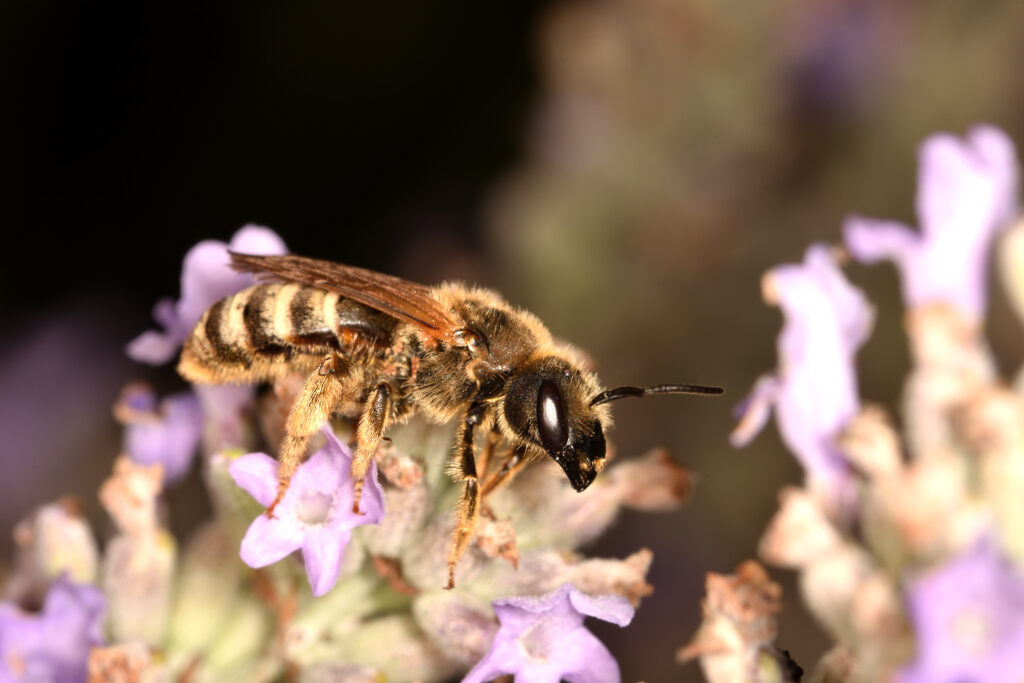
While sweat bees can sting, their stings are generally less painful than those of larger bees.
©Davide Bonora/Shutterstock.com
The small yet mighty sweat bees are a diverse group of bees known for their affinity for human perspiration. Though they might be tiny, these bees play a crucial role in pollination. Let’s discover more about these pint-sized powerhouses.
Physical Characteristics
Sweat bees are tiny, often measuring between 0.125 and 0.5 inches long. They come in a variety of colors, from metallic green or blue to more subdued black and brown hues. As their name suggests, they’re attracted to human sweat, which provides them with essential salts and moisture.
Sting Pain Level: Moderately Painful
While sweat bees can sting, their stings are generally less painful than those of larger bees. Scoring between 1.0 and 1.5 on the Schmidt Sting Pain Index, their stings can be mild to moderately painful. But fear not, as these little bees are more interested in your sweat than in causing discomfort.
Habitat and Distribution
Sweat bees are adaptable and can be found in a wide range of habitats throughout North Carolina. They’re often seen buzzing around flowers in gardens, meadows, and forests. Some species nest in the ground, while others prefer rotting wood or plant stems, making them an integral part of the local ecosystem.
5: Mining Bees (Andrena spp.)

Look for the small mounds of soil they leave behind, evidence of their industrious excavation efforts.
©Gabi Wolf/Shutterstock.com
The hardworking mining bees are expert excavators that create intricate underground homes. With their keen sense of purpose, these bees are essential contributors to our ecosystem. So let’s dig deeper into the fascinating lives of these subterranean architects.
Physical Characteristics
Mining bees are medium-sized, usually measuring between 0.3 and 0.6 inches long. They exhibit diverse colors, from black and brown to reddish shades, often with grayish or pale hair. Known for their strong mandibles, they’re well-equipped to burrow into the ground and construct their nests.
Sting Pain Level: Moderately Painful
Though mining bees can sting, they’re generally non-aggressive and rarely bother humans. Their stings, which score between 1.0 and 1.5 on the Schmidt Sting Pain Index, are considered moderately painful. With their focus on digging and nesting, they’re unlikely to cause trouble for passersby.
Habitat and Distribution
Mining bees are found across North Carolina, from forests and meadows to gardens and urban environments. They prefer well-drained soil, where they dig their burrows and lay their eggs. Look for the small mounds of soil they leave behind, evidence of their industrious excavation efforts.
6: Mason Bees (Osmia spp.)
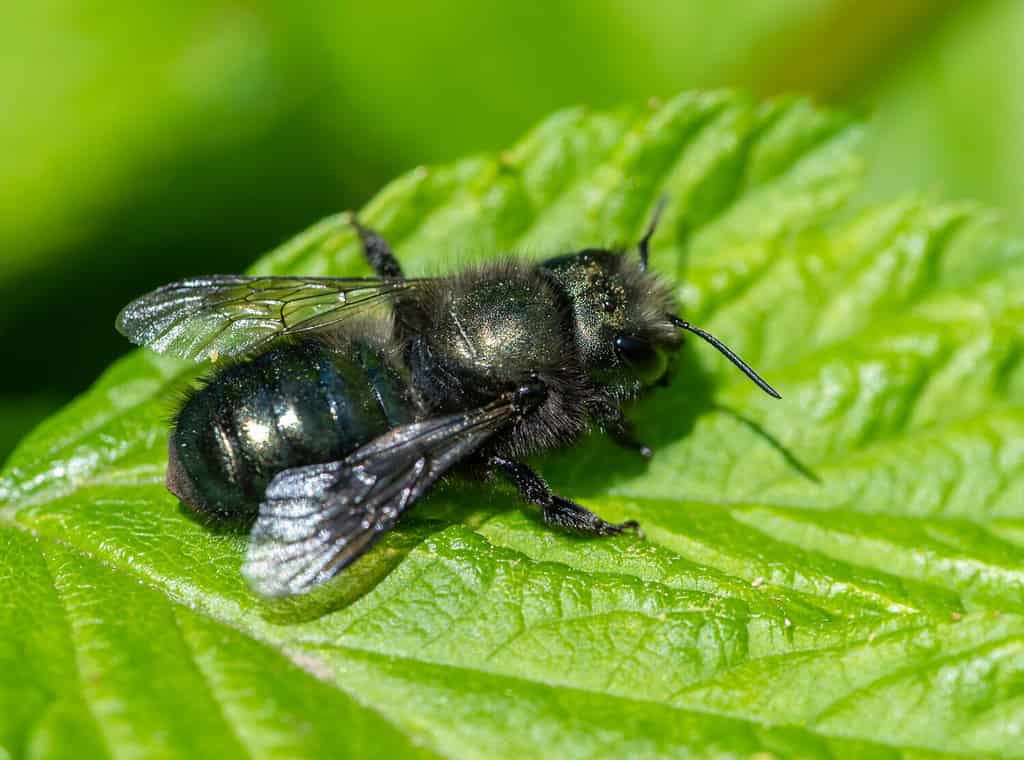
Their stout bodies and short antennae give them a distinctive appearance, setting them apart from other bees.
©Jennifer Bosvert/Shutterstock.com
Meet the skilled builders of the bee world—mason bees! These solitary insects are renowned for their efficient pollination skills and their remarkable nest-building expertise. Let’s explore the unique lifestyle of these winged masons.
Physical Characteristics
Mason bees are small, measuring about 0.3 to 0.5 inches long. They display a striking range of colors, from metallic green or blue to dark brown, often with a metallic sheen. Their stout bodies and short antennae give them a distinctive appearance, setting them apart from other bees.
Sting Pain Level: Mildly Painful
Mason bees are known for their gentle nature, and while they can sting, their stings are considered mildly painful. Scoring between 0.5 and 1.0 on the Schmidt Sting Pain Index, their stings are far less severe than those of some other bees on our list. In addition, Mason Bees are typically more interested in building their nests than in bothering humans.
Habitat and Distribution
Mason bees can be found throughout North Carolina in diverse habitats, including gardens, meadows, and woodlands. They’re solitary nesters, often using pre-existing cavities or hollow stems to build their nests. Keep an eye out for their distinctive mud partitions, a signature feature of their expert masonry work.
7: Leafcutter Bees (Megachilidae spp.)
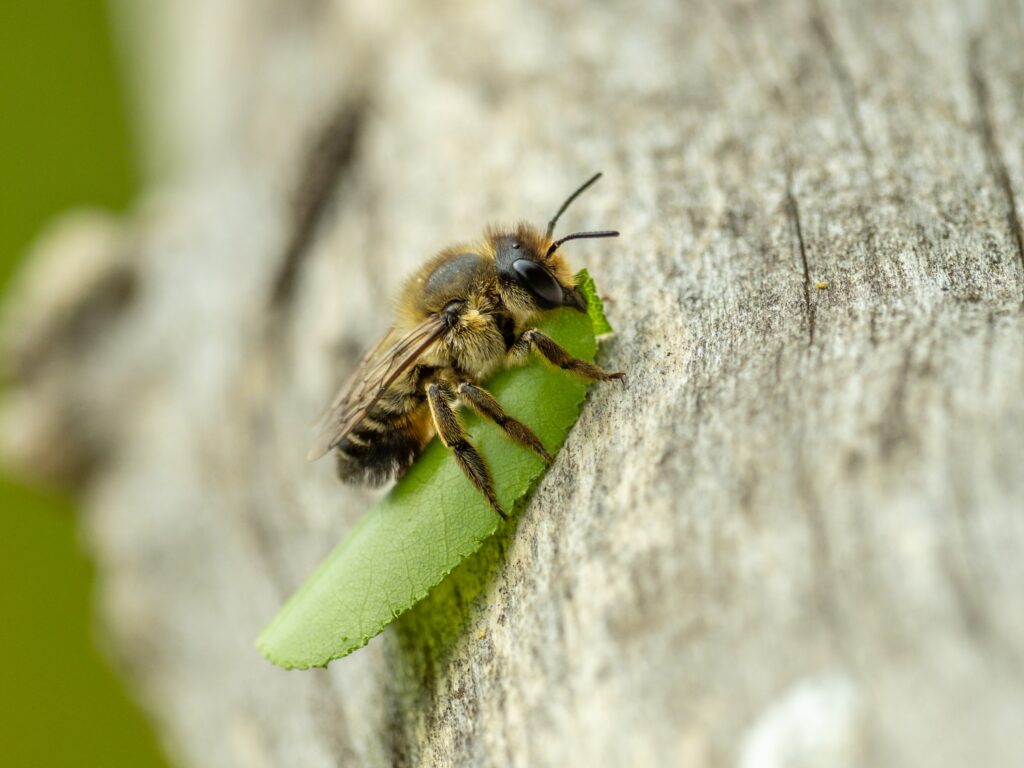
These industrious insects are more preoccupied with leaf-cutting than causing discomfort.
©Keith Hider/Shutterstock.com
Welcome to the world of leafcutter bees, the master crafters that shape leaves into cozy homes for their young. With their remarkable gardening skills and pollination prowess, these bees are truly one of a kind. Let’s learn more about these creative cutters.
Physical Characteristics
Leafcutter bees are medium-sized, usually ranging from 0.2 to 0.6 inches long. They exhibit various shades of black, brown, or metallic green, often with bands of pale hair on their abdomen. Their mandibles are uniquely designed with serrated edges, perfect for snipping leaves with precision.
Sting Pain Level: Mildly Painful
Although leafcutter bees can sting, they’re non-aggressive and generally pose little threat to humans. Their stings score between 0.5 and 1.0 on the Schmidt Sting Pain Index, categorizing them as mildly painful. These industrious insects are more preoccupied with leaf-cutting than causing discomfort.
Habitat and Distribution
Leafcutter bees are found in various habitats across North Carolina, from gardens and meadows to forests and urban settings. They’re solitary nesters, frequently constructing their nests in cavities or hollow plant stems. Keep an eye out for the telltale circular cuts on leaves, a sure sign of their handiwork.
8: Long-Horned Bees (Eucerini Tribe)
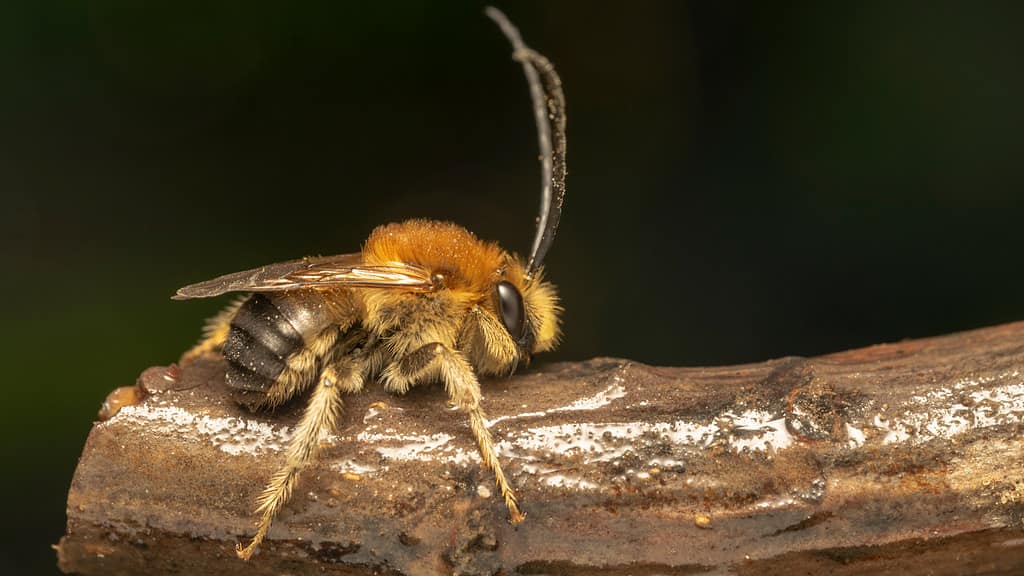
Long-horned Bees can be found throughout North Carolina, frequenting meadows, gardens, and fields.
©tasnenad/Shutterstock.com
These striking insects have antennae that steal the show. As proficient pollinators with a penchant for sunflowers, these bees add a touch of elegance to the buzzing world. Let’s discover more about these long-antennaed wonders.
Physical Characteristics
Long-horned bees are medium-sized, typically measuring between 0.3 and 0.6 inches long. They come in various colors, from black and brown to shades of yellow or orange, often with bands of pale hair. Their standout feature is their elongated antennae, which can be more than half their body length in males.
Sting Pain Level: Mildly Painful
While long-horned bees can sting, they’re not aggressive and generally keep to themselves. Their stings register between 0.5 and 1.0 on the Schmidt Sting Pain Index, making them mildly painful. These bees are more focused on pollination and finding the perfect sunflower than on causing harm.
Habitat and Distribution
Long-horned Bees can be found throughout North Carolina, frequenting meadows, gardens, and fields. They have a particular affinity for sunflowers and other members of the Asteraceae family. In addition, these solitary bees often build their nests in sandy soil, making them an integral part of the local ecosystem.
9: Small Carpenter Bees (Ceratina spp.)
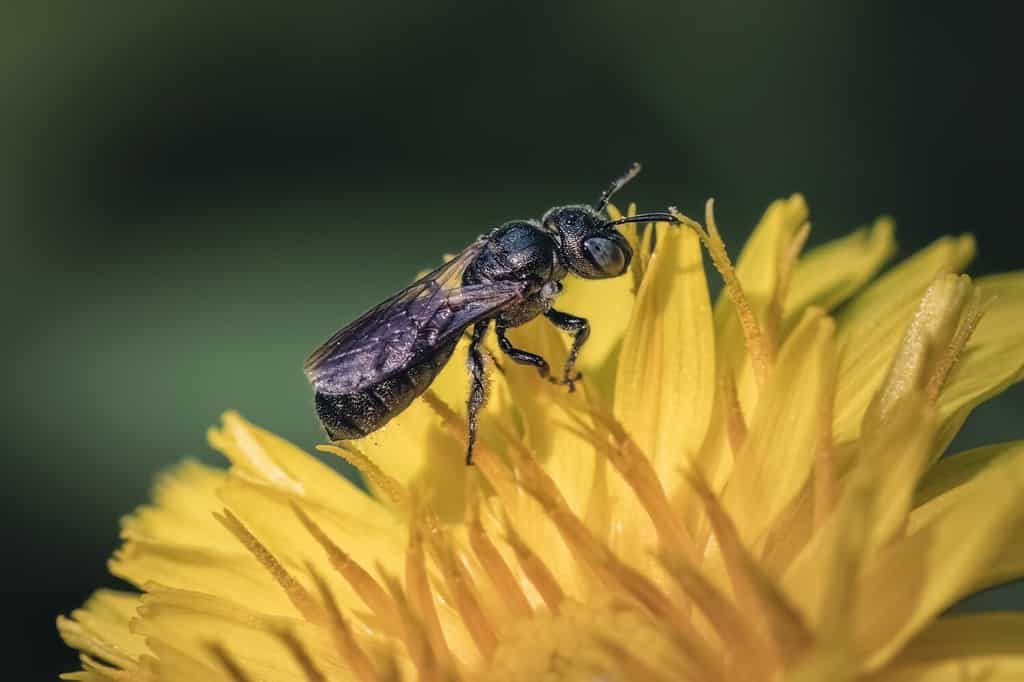
They’re particularly fond of soft-stemmed plants, which they use to create their nests.
©Victoria Virgona/Shutterstock.com
These bees are petite relatives of the eastern carpenter bee with an equally impressive talent for nest-building. Though tiny in size, these bees play a big role in pollination. Let’s get to know these miniature marvels.
Physical Characteristics
Small carpenter bees are, as their name suggests, quite small, typically measuring between 0.2 and 0.4 inches long. They display a range of colors, from metallic green or blue to black, often with a metallic sheen. Like their larger counterparts, they possess the remarkable ability to excavate nests within plant stems.
Sting Pain Level: Mildly Painful
Small carpenter bees can sting, but they’re not aggressive and tend to keep their distance from humans. Scoring between 0.5 and 1.0 on the Schmidt Sting Pain Index, their stings are mildly painful. This is because these tiny bees are more focused on nest-building than causing discomfort.
Habitat and Distribution
You’ll find small carpenter bees across North Carolina in a variety of habitats, from meadows and gardens to wooded areas. They’re particularly fond of soft-stemmed plants, which they use to create their nests. Look for small holes in plant stems, a clear indication of their presence and handiwork.
10: Cuckoo Bees (Nomadinae spp.)
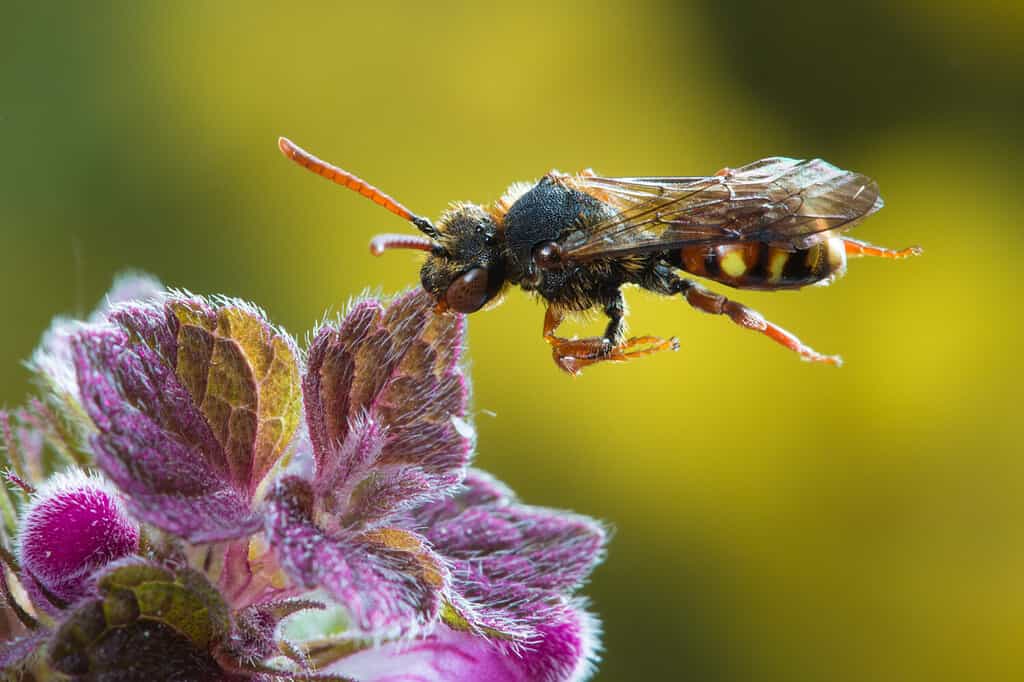
They’re parasitic bees, laying their eggs in the nests of other bee species, primarily mining bees.
©Geza Farkas/Shutterstock.com
The intriguing cuckoo bees are the freeloading members of the bee world that have a unique approach to parenthood. With their striking appearance and unconventional lifestyle, these bees are truly fascinating. Let’s delve into the mysterious lives of these winged wanderers.
Physical Characteristics
Cuckoo bees are slender and wasp-like, usually measuring between 0.2 and 0.6 inches long. They exhibit a stunning array of colors, from red, black, or yellow to combinations thereof, often with striking patterns. Unlike other bees, they lack the hair necessary for pollen collection, a result of their peculiar lifestyle.
Sting Pain Level: Mildly Painful
Though cuckoo bees can sting, they’re not aggressive and rarely interact with humans. Their stings register between 0.5 and 1.0 on the Schmidt Sting Pain Index, making them mildly painful. These bees are more interested in finding suitable hosts for their offspring than in causing discomfort.
Habitat and Distribution
Cuckoo bees are across North Carolina in habitats such as meadows, gardens, and forests. They’re parasitic bees, laying their eggs in the nests of other bee species, primarily mining bees. Keep an eye out for these secretive insects as they search for the perfect nest to hijack.
Key Takeaways
And there you have it—the buzz on the ten types of bees found in North Carolina, ranked by their sting pain levels! So, the next time you’re out exploring North Carolina’s great outdoors, keep an eye out for these buzzing beauties and remember to respect their space. After all, a world without bees would be a lot less colorful and fruitful.
The photo featured at the top of this post is © Maurice Lesca/Shutterstock.com
Thank you for reading! Have some feedback for us? Contact the AZ Animals editorial team.







